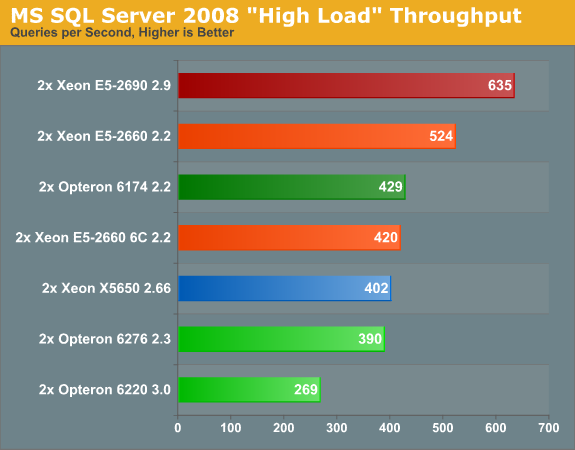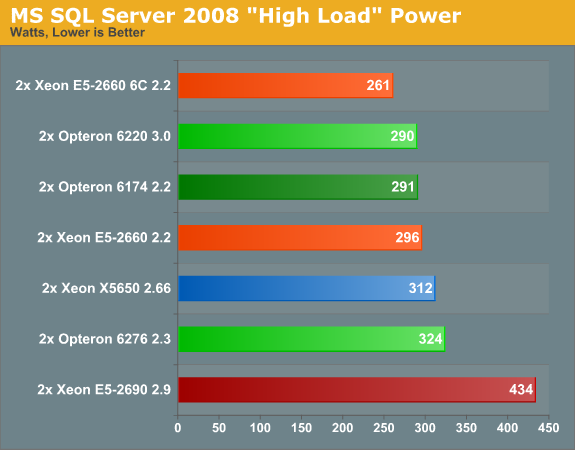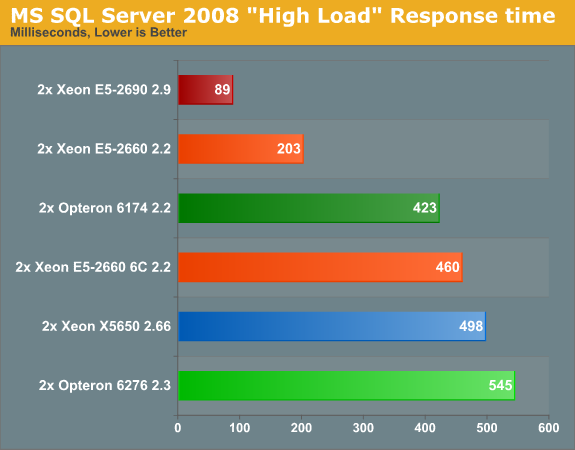The Xeon E5-2600: Dual Sandy Bridge for Servers
by Johan De Gelas on March 6, 2012 9:27 AM EST- Posted in
- IT Computing
- Virtualization
- Xeon
- Opteron
- Cloud Computing
SQL Server 2008 Enterprise R2
We have been using the Flemish/Dutch Web 2.0 website Nieuws.be as a benchmark for some time. 99% of the loads on the database are selects and about 5% of them are stored procedures. You can find a more detailed description here.
We have improved our testing methodology (read more about it here) and updated the SQL Server, so the results are only comparable to our last Opteron 6276 review (and not comparable to older ones than the latter).

Since performance/watt is an extremely important metric, we follow up with a power measurement:

The Xeon E5-2690 is by far the fastest in this discipline, but the difference power consumption compared to the rest of the pack is significant. The Xeon E5-2690 needs 140W more than its slower brother, the 95W TDP Xeon E5-2660. That is 70W extra per CPU. This clearly indicates that the fastest Xeon is running closer to its TDP than the 2.2 GHz version. The Xeon E5-2660 offers more than 20% better performance per Watt than the 135W TDP Xeon.
The Xeon E5-2660 is especially impressive if you compare it with the older Xeon. Despite the lower clockspeed, the new Xeon is capable of outperforming the Xeon 5650 by 30%.
Clock for clock, core for core the Xeon E5 is 23% more efficient at SQL Server workloads than its older brother. Considering that it is pretty hard to extract higher IPC out of server workloads, we can say that the Sandy-Bridge architecture is a winner when it comes to SQL databases.
Finally, let's check out the response times with 600 users sending off a query every second (on average):

Response times are more or less linear (and low!) when the server is not yet saturated . Once the server is closer to or over its maximum throughput, response times tend to increase almost exponentially. Since the Xeon E5-2690 is capable of sustaining more than 600 users, it can still offer a very low response time. The other CPUs are saturated at this point.
But as we pointed out in our previous article, server benchmarks at 100% are just one datapoint and we should test at lower concurrencies as well. Most people try to make sure that their database server almost never runs at 100% CPU load.










81 Comments
View All Comments
MrSpadge - Tuesday, March 6, 2012 - link
Put some sarcasm tags in there to save some people from getting confused...cynic783 - Tuesday, March 6, 2012 - link
definitely sarcastic. i was actually surprised not to see any fanbois so I thought I'd pretendbadjohny - Tuesday, March 6, 2012 - link
I have no doubt these chips or something similar will end up in the new mac pros. Who are in a very bad need of a refresh.Shuxclams - Tuesday, March 6, 2012 - link
Looking at a complete visualization transformation in our server room, looks like the decision was made for us as far as architecture. Wow....TeXWiller - Tuesday, March 6, 2012 - link
<quote>The new Xeon also supports faster DDR-3 1600. Contrary to the Interlagos Opteron which can only support this memory speed with one DIMM per channel</quote>Interlagos supports memory up to DDR3-1600 using two single rank memory modules, or one single rank and one double rank module if using registered memory, and two single rank modules if using unbuffered memory. DDR3-1866 is supported on a single load-reduced registered, or on a single unbuffered module per channel. It depends on the board manufacturer and more importantly, it can be all read on the manual, so to speak.davegraham - Tuesday, March 6, 2012 - link
AMD Interlagos can support more than 1 DDR3-1600 ECC/REG dimm per channel. I run 8 on a single socket 6276 and it works at the rated speed.TeXWiller - Wednesday, March 7, 2012 - link
Too bad these kinds of errors in the articles are not usually fixed.JohanAnandtech - Wednesday, March 7, 2012 - link
I will double check .meloz - Tuesday, March 6, 2012 - link
Just wanted to congratulate Johan on a job well done. Very thorough analysis, Intel have achieved a very dominant position with this new platform and this is reflected in pricing of their processors as well!AMD was already a sub 10% niche (with a market share to mirror) in the data center, now even that niche has evaporated.
New Opterons (based on Piledriver) might decrease the performance gap to Intel under certain benchmarks, but I doubt they will beat Intel. Intel has plenty of SKUs above the quickest AMD Opterons to adjust prices and kill any new challenge from AMD, instantly.
JohanAnandtech - Wednesday, March 7, 2012 - link
Thanks! Although I hope Intel gets a bit more competition though.